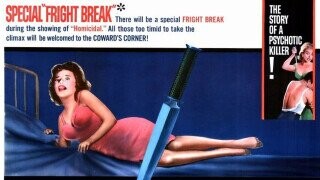The B-Movie Gimmick From The '60s (That We Want Back)

We’ve discussed William Castle here at Cracked, the all-time king of horror movie gimmicks. And among all his contrivances to get butts in theater seats to watch B-grade schlock, there's a particularly clever one used in one of his ‘best’ movies, Homicidal. This 1961 film came a year after Psycho, let’s say, ‘inspired’ by it, and the similarities between Hitchcock and Castle’s movies are so clear that even to say ‘spoiler alert’ pretty much gives the main, cross-dressing one away.

Columbia Pictures
And here we arrive at Homicidal’s specific gimmick: its ‘fright break.’ You see, just as the movie’s mysterious, murderous character is one step closer to being revealed in its spooky final twist, Homicidal slows down, pumps up the sound of a beating heart, and Castle’s voice emerges to tell you you have 45 seconds to leave the theater while a literal clock is shown counting down on the screen. Here, take a look … if you dare.
I like to imagine a viewer with a phobia of clocks watching this movie.
Here the story is the stuff of B-movie legend: Castle’s taunt offered to reimburse the ticket to people leaving the theater, but moviegoers instead stayed in their seats to see the following screening and then left the theater, thus indeed getting their money back. As a response, Castle’s natural solution was doubling down by creating yet another gimmick, the ‘coward’s corner,’ a literal corner in the theater with mocking sounds and signs where people would have to wait in order to be refunded.
Now, if other gimmicks have returned as novelties or simply refused to go away like 3D, the fright break was soon forgotten. Yet, there is one specific movie that brought it back in its own deeply unsettling manner. This is Gaspar Noé’s 1998 art-house French film, Seul Contre Tous. And seriously, unlike Homicidal, I Stand Alone is no trend-following cash cow. Noé is better known as the director of the astonishing Irreversible and the recent horror movie Climax, both of them being highly recommended yet, erm, ideally watched surrounded by fluffy kittens.
I Stand Alone is Noé’s first movie. We won’t go deep into spoilers here, but it tells the hyper-violent, profoundly depressing story of the Butcher, a down-on-his-luck mess of a man. And he’s no anti-hero: the Butcher goes through the movie ruminating on his hatred of the world and on those who’ve supposedly wronged him and continually acts in erratic, spiteful, brutal ways. But tensions mount near the end of the movie when in his desperation, the Butcher goes to see his daughter, a mute girl who abandoned him years earlier. Again, no spoilers -- because also, eww -- but as both of them ride the train to the Butcher’s room, well, William Castle’s ghost returns in all his gimmicky glory (relax, no fluffy kittens needed for this clip):
Yup, that is Castle’s fright break alright. It’s not a literal clock nor Homicidal’s exact 45 seconds, yet it is pretty much known that I Stand Alone’s 30-second warning was inspired by Castle. This is simply fascinating. French film's influence on Hollywood is pretty well-known … but the other way around? I mean, sure, François Truffaut was a big fan of Hitchcock, but here we have a one-time, forgotten B-movie gimmick being recycled by an artsy, ‘serious’ piece of French art-house cinema. Can this become a genre in itself? Because some movies are in desperate need of 30-second warnings, things are only gonna get worse.
For example, here’s your 2-minute, 32-second warning to avoid this one:
Top Image: Columbia Pictures